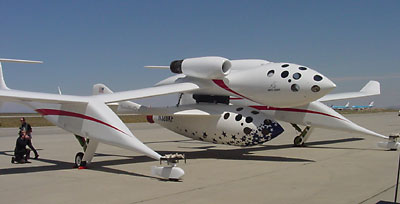Easing regulatory uncertaintyby Jeff Foust
|
| A lack of rigorous definitions forced regulators regulators to take the Potter Stewart approach to suborbital launch vehicles: they knew one when they saw it. |
With the current generation of suborbital vehicles, though, the distinction between launch vehicle and aircraft becomes blurred. These vehicles use rocket power to fly to the edge of space—100 kilometers altitude or higher—but also incorporate aircraft-like characteristics, notably wings, used to control the vehicle during the low-altitude phases of the flight. An example is Scaled Composites’ SpaceShipOne: the vehicle can fly as a glider, as it has on four occasions to date, relying solely on its wings and other aerodynamic surfaces. However, it’s designed to be fitted with a rocket motor that will allow it to fly to 100 kilometers and exceed three times the speed of sound. SpaceShipOne and its ilk look little like the sounding rockets for which AST has previously issued suborbital launch licenses.
Nonetheless, most suborbital vehicle developers assumed that they would be regulated by AST as launch vehicles. That assumption was shattered in April at the unveiling of SpaceShipOne, when Burt Rutan said that he planned to fly the vehicle under an experimental airworthiness certificate (EAC) rather than obtain a launch license. (See “Rutan aims for space: A look at SpaceShipOne”, April 21, 2003.) This raised concern among other vehicle developers that Rutan could set a precedent requiring other vehicles to also obtain an EAC rather than a launch license.
Flying under an experimental certificate has both its advantages and drawbacks. An EAC, issued by the FAA’s Office of the Associate Administrator for Regulation and Certification (AVR), is usually easier to obtain than a launch license and can offer the vehicle operator a greater degree of flexibility. However, a vehicle flying under an EAC typically cannot be put into commercial service. Instead, the vehicle has to be certified by AVR, a process that can take years and cost ten or more times the amount spent to develop the vehicle itself. (See “RLV regulation: licensing vs. certification”, April 28, 2003.)
In the months since the SpaceShipOne rollout, most of the rest of the suborbital vehicle community have scrambled to make sure that they are considered launch vehicles and not aircraft. They argued that while obtaining a launch license might require more up-front work than an EAC, it was the only way a commercial suborbital industry could develop and flourish. “The only regulatory regime that we have that allows safe flight for the general public while permitting revenue operation of untried vehicles is the launch vehicle regulatory regime,” Jeff Greason of XCOR Aerospace said before a joint House-Senate hearing on commercial human spaceflight in July. (See “The regulatory hurdles to commercial human spaceflight”, July 28, 2003.). “That’s how we have to fly.”
The debate created another problem: uncertainty among both the industry and observers about how the industry would be regulated. That uncertainty could have a particularly chilling effect on the investment community, who seek to avoid regulatory risk wherever possible. “The only big problem that stands before myself and others who want to do this [invest] is the regulatory risk,” Dennis Tito, space tourist and potential investor, said at the same hearing.
Fortunately, that uncertainty has cleared up, at least in the near term. On October 20 the FAA published a notice in the Federal Register outlining how it defined suborbital vehicles and what licenses or certificates it would require. (The notice was republished in the Federal Register on October 27 to correct some errors in the original notice.) The notice, signed by both AST head Patti Grace Smith and AVR head Nicholas Sabatini, incorporates the definitions for suborbital vehicles and suborbital trajectories that AST first announced six months earlier at the Space Access ’03 conference in Arizona. Those definitions were well-received by suborbital vehicle developers at that time.
| Uncertainty regarding how suborbital vehicles would be regulated could have a particularly chilling effect on the investment community, who seek to avoid regulatory risk wherever possible. |
Those definitions, as applied in the notice, make it clear the suborbital launch vehicles will need a launch license. “Suborbital RLVs, including those that employ traditional aviation characteristics, such as wings and landing gear, are regulated under the RLV mission licensing requirements,” the notice states. The notice adds, though, that for some “hybrid” vehicles, with characteristics of both aircraft and launch vehicles, an EAC may also be required, particularly for the case of a vehicle that “includes operation of a civil aircraft for any portion of flight.” In such cases the FAA may require the vehicle developer to obtain an EAC as a condition for receiving a launch license.
The regulations also allow suborbital vehicles to perform some test flights without a launch license. “A license will be required only for those vehicles that operate as a suborbital rocket and that are launched,” the notice states. In other words, test flights of vehicles that don’t feature a launch can fly with just an EAC. For example, the series of captive carry and glide tests for SpaceShipOne carried out in recent months required only an EAC. In addition, some flights that do low-powered rocket engine tests can also get by without a launch license by utilizing the “amateur rocket activities” exemption to launch licensing, provided they meet the criteria for the exemption.
